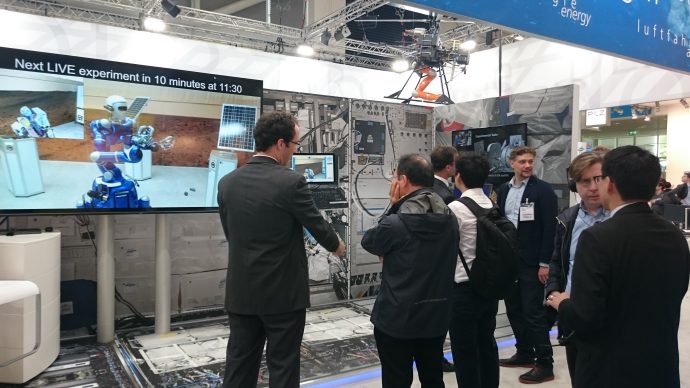FURTHER READING
German Astronaut Alexander Gerst to command Justin from in ISS in August
NASA Astronaut Scott Tingle works with Rollin’ Justin from the ISS
SUPVIS Justin ISS session #2 set for March 2, 2018
23rd June 2016, by Dr. Neal Y. Lii
SUPVIS Justin at Automatica 2016

Our first live demonstration for the general public of the SUPVIS-JUSTIN telerobotics experiment from remote is being shown at Automatica 2016.
The Robotics and Mechatronics Center (RMC) is showcasing our robotics technology at Automatica, the 7th International Trade Fair for Automation in Munich, Germany from 21st to 24th of June. The trade fair brings together robotics and automation professionals from around the world to share the most current technologies in the field, as well as to give an indication of the new trends in robotics.
The SUPVIS Justin team is performing live demonstrations of our telerobotics experiment, around the clock throughout the four days of the trade fair. Our intuitive tablet interface is installed in a full-sized Columbus Module of the International Space Station on site at Automatica. The tablet is used to command DLR’s humanoid robot, Rollin’ Justin, located in Oberpfaffenhofen, 50 kilometers away. This is our first live demonstration of remote teleoperation given to the general public.
The “astronauts”, played by our team members, as well as some show attendees, are able to command the robot to perform the tasks necessary for maintaining and servicing a solar power station, implemented in the Solex experimental environment located at the RMC in Oberpfaffenhofen. Justin is commanded to identify and navigate to the defective solar panel unit(s), and perform a series of maintenance and repair tasks.
Throughout Automatica, we are witnessing a great deal of interest from the international robotics community and technology firms, which helps to raise the awareness of the SUPVIS Justin mission, as well as space telerobotics as a whole. Our discussions with the experts in different technology sectors are also helping us to identify possible venues to apply our technology to other applications, and future space missions. In addition, the grueling continuous operation has been a good litmus test for the robustness of our robot, Justin, and the intuitiveness of the tablet software. Thanks to the success of over 100 live demos, our confidence in the mission is riding high.